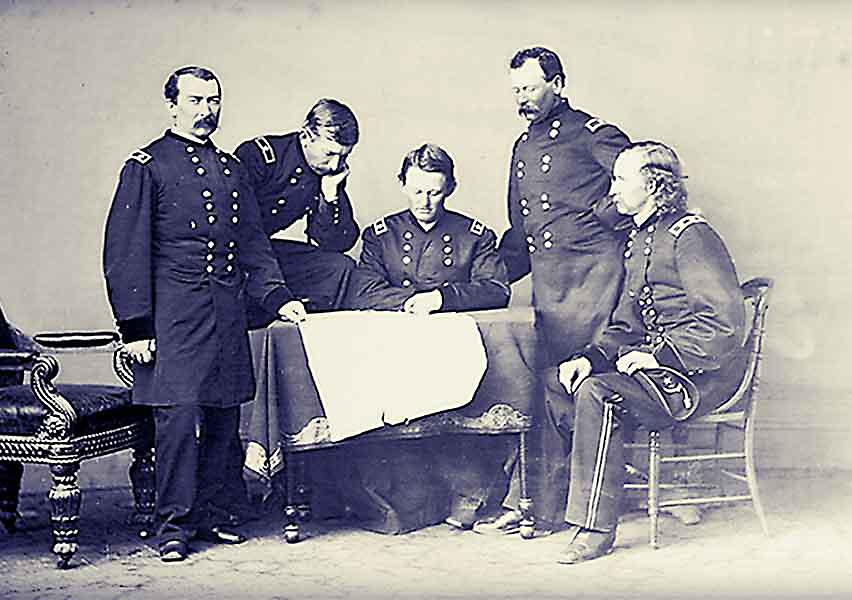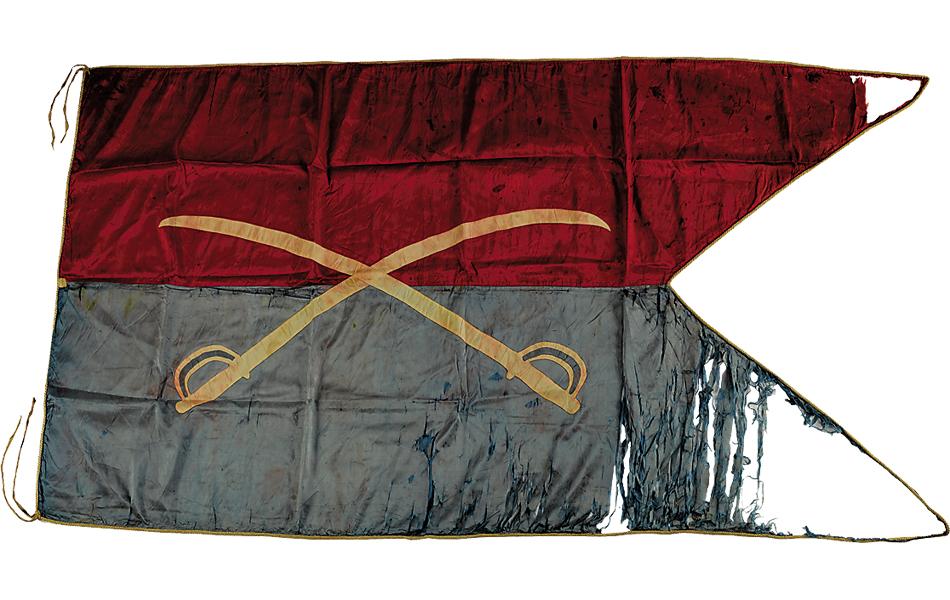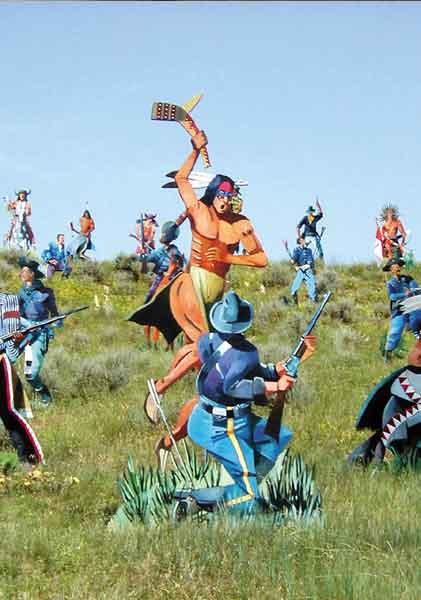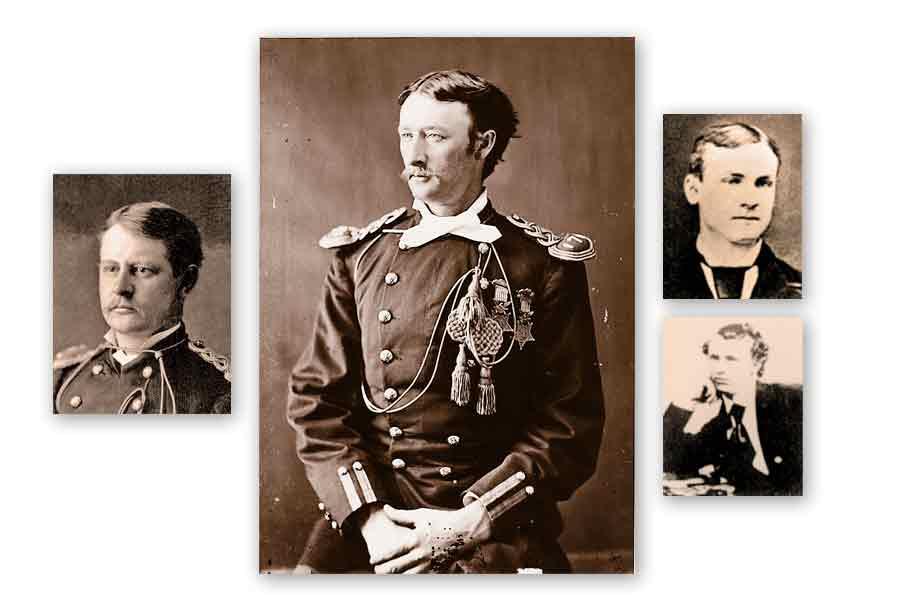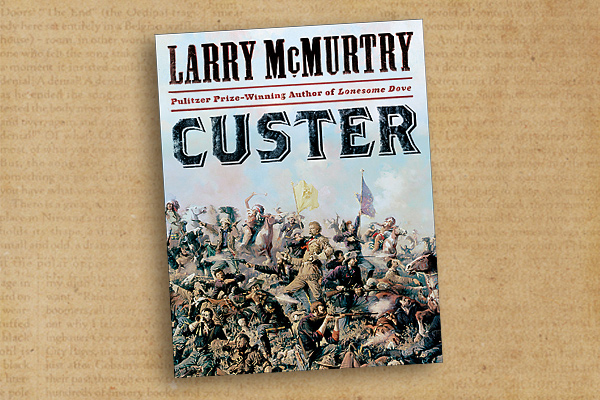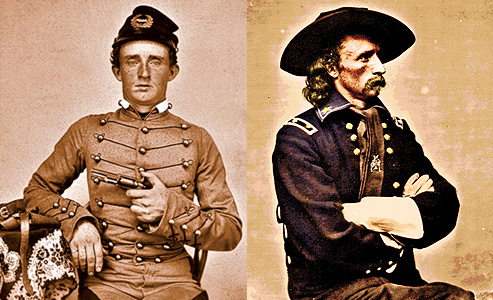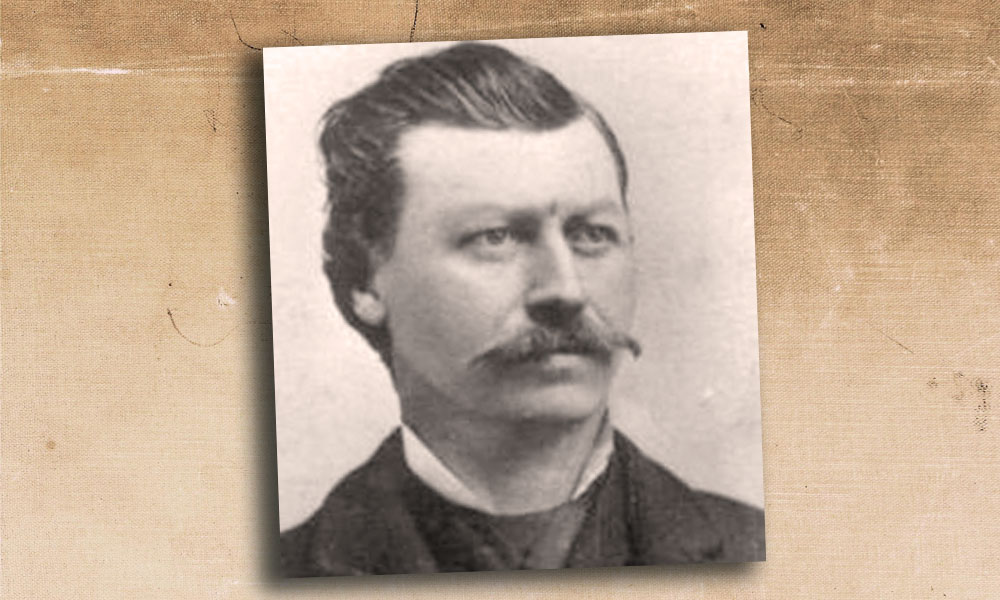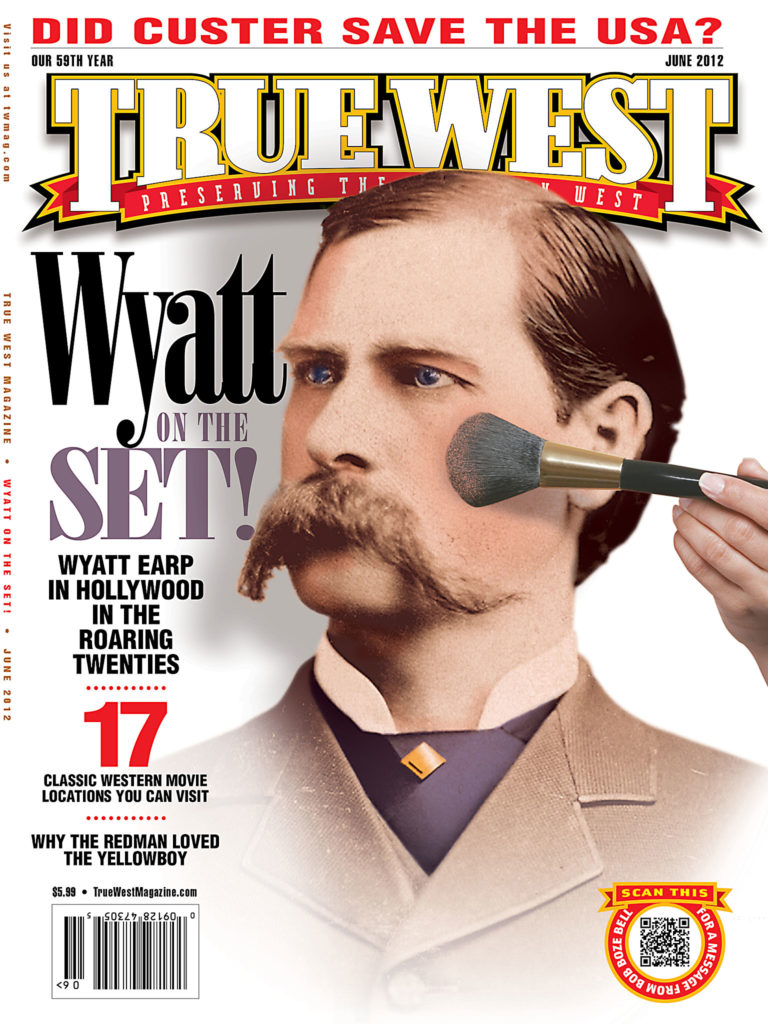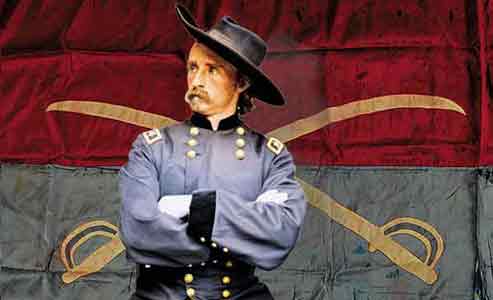 He is the man everybody loves to hate. George Armstrong Custer, once one of the most admired American military heroes, has become, in our time, one of the most hated figures from our past. He is now, at best, a national joke (“Custer wore arrow shirts!”) and the poster boy for American arrogance, blundering military stupidity and genocidal cruelty toward all Indians.
He is the man everybody loves to hate. George Armstrong Custer, once one of the most admired American military heroes, has become, in our time, one of the most hated figures from our past. He is now, at best, a national joke (“Custer wore arrow shirts!”) and the poster boy for American arrogance, blundering military stupidity and genocidal cruelty toward all Indians.
There is little doubt that Custer’s arrogance contributed to the final battle that came to define his historical image, but that same arrogance made him one of the most successful soldiers of his era. It is important to view the entire heroic trajectory of his life. Only then can we understand how this young soldier may very well have saved our nation.
Let’s start in June 1863, when Custer, at 23, became the youngest general in the Union Army. By the end of the Civil War, two men younger than Custer’s 23 years would reach the rank of general; they are both long forgotten.
Custer had the good fortune of being in the right place at the right time in all the major battles in the Eastern Theater. From directing the retreat across the clogged bridge at the First Battle of Bull Run in 1861 to the 1865 surrender at Appomattox, Custer was there in the thick of the fight.
In his book Lost Triumph, author Tom Carhart makes a strong case that Custer’s bravado and aggressive battle behavior are what, in effect, saved the Union at Gettysburg on the Third Day and, hence, the entire country.
Custer had led two charges against J.E.B. Stuart’s superior cavalry and, by stalling him, had kept the Rebel cavalry from hitting the back of the Union line at the moment that Pickett’s Charge bore down on the defenders behind the Angle.
At Appomattox Custer received the first flag of surrender from the Confederate Army. He rode into Confederate lines, almost demanding the flag, when Lt. Gen. James Longstreet came up to this poppin-jay, long-haired, young general and told him to skedaddle or else they’d pull down their white flag and shoot him. Custer wisely returned to the more friendly lines of the Union Army.
Custer was there for the surrender too. Sitting at separate tables in Wilmer McLean’s parlor, Union Gen. Ulysses S. Grant and Confederate Gen. Robert E. Lee worked out the terms of the surrender that signaled the end of the Civil War. After Lee and his adjutant rode away, the victorious Union officers began to take everything in the room. Poor Wilmer ran around begging them to either return the stuff or at least pay for it. Major Gen. Phil H. Sheridan bought the table Grant had sat at for $20.
Intending the table as a gift for one of his junior officers, Sheridan wrote out a short note:
He then gave the table to Custer as a gift for his wife, Libbie. The Boy General rode out of Appomattox with the table balanced on his head; it now resides in the Smithsonian, maybe the most famous table in American history.
To the men who had fought with Custer between 1861-65, he was no buffoon. They saw him as a hard-fighting Ohio farm boy who acted as Sheridan’s sledgehammer. Neither was he a joke to Rebel army troops who had come to truly hate him. His stature as a legitimate Civil War hero had been established through real deeds of blood and thunder; he never ordered his men to go where he, himself, would not go.
Having never even considered a career in the military (Custer had gone to West Point because it was free!), he now found himself the rage of Washington, DC. With the end of the war, Custer’s brevet rank was reduced from major general to his rank of captain. He was then promoted to lieutenant colonel of the newly formed 7th Cavalry. As with all men of such stature, he was still called Gen. Custer out of respect for having attained that rank.
Custer Out West
Starting in 1866, Custer found himself out on the prairies of Kansas and Texas, chasing Indians. Unlike the Confederates, the Indians did not fight in the same manner; all the American officers were befuddled by the Indians’ tactics of hit-and-run or complete disappearance. Custer was no better, nor worse, than his peers. The problem was, without combat, Custer and his peers had no chance for promotion, hence no chance to improve their financial situation.
During his Civil War career, Custer had already gone from captain to major general in a year, an amazing climb that was good for his ego. Yet when he first rode onto the plains of the frontier, he was a lieutenant colonel; he would stay a lieutenant colonel for the remaining 11 years of his life.
This static state frustrated Custer. It got so bad, he even considered resigning from the Army to look for a better-paying job. Yet he was thriving in the open spaces of the West, where he enjoyed hunting and collecting animals, which he sent back to the fledging zoo in New York City (he sent so many animals that they had to tell him to stop it). As a self-taught taxidermist, he worked late into the night, as his men fell asleep in their camps. Custer was tireless and energetic to a fault.
Because of bad pay, loneliness, isolation, boredom and bad food, many of his men tried to desert. At one time, he even ordered troops to shoot deserters; one of the three men shot died. For this and other charges (such as force marching his troops to see how his wife was faring during a cholera outbreak), Custer was court-martialed in 1867 and relieved from rank for a year with no pay.
When he returned, his actions had caused a riff in the troops. Plus, he had his own clique of pals, which did not sit well with those on the “outside,” like Maj. Marcus Reno and Capt. Frederick Benteen, two men who would figure prominently in events to come.
Fighting for Gold
Due to gold discoveries in places like Deadwood, Dakota Territory, the federal government, wanting to take the land away from the Indians, ordered all wandering bands to report to their reservations by January 31, 1876, or else they would be considered hostile. Well, no band of Indians could move to a reservation in the dead of winter, which was why that date was chosen in the first place. The government (not Custer!) promptly declared war on these “hostiles.”
The Indians, of course, had no idea they were outlaws; they were too busy going about their business hunting buffalo and, sadly, enjoying the last few years left to them as truly free people.
Having only a general idea of where the roving bands of Lakota (Sioux) and Cheyenne (both Northern and now Southern bands) were, the government sent out three armies to deal with them. Colonel John Gibbon headed east from Fort Ellis in western Montana. Brigadier Gen. George Crook headed north from Fort Fetterman in southeastern Wyoming. Brigadier Gen. Alfred Terry led his army west from their base at Fort Abraham Lincoln in western North Dakota. Along with Terry rode Custer at the head of his almost 700-men unit of the 7th Cavalry.
Along the banks of the Yellowstone, Gibbon and Terry met up to discuss plans of action. Little did they know that on June 17, Crook and his men had fought a draw with Lakota and Cheyenne warriors on Rosebud Creek. Realizing they had shot away all their ammunition, the troops turned around and, without telling a soul, returned to Wyoming and went fishing. Gibbon and Terry had no clue they were now the only force in the area!
These uninformed generals decided to send Maj. Reno southward on a scout. Several days out he came upon a large trail that suggested a massive village had moved through the area recently. He returned and made out his report.
Neither Terry nor Gibbon had ever fought Indians. Despite the fact that Custer himself had not fought them all that often, the two generals ordered Custer and his 7th Cavalry to follow the trail to locate the whereabouts of the Indian village. The order, as orders can be, was both specific and vague; much was left to Custer’s discretion.
Gearing Up for the Campaign
Terry and Gibbon did offer Custer some reinforcements for the mission. Custer refused the battery of Gatling guns. Since the massive guns would have to be drawn by horses no longer fit for cavalry service, he felt they would be an impediment to his mobility. He also refused another group of cavalrymen, the 2nd Cavalry. Having more than 600 men (the 7th was the largest single unit in both Gibbon and Terry’s command), Custer felt confident the 7th could handle anything it ran into during the reconnaissance.
As misguided as his confidence proved to be, Custer was relying on military strategy and tactics he thought were accurate.
First, he knew that fighting Indians was not like fighting Confederates, the British or the French. Warriors, first of all, had to defend their families, their villages and their property. That was why a smaller cavalry unit could consistently win a pitched battle with Indians. Even with superior numbers, the Indians knew they had to preserve the lives of their people, so they often fought a rearguard action while the village was dismantled and the occupants fled. Thus, Custer was not overly concerned about how large an Indian encampment might be; his worry lay in finding it.
Second, before riding on the campaign, Custer, like any officer, checked with Indian agents and sutlers to find out how many Indians were on the various reservations and also how many of them were not on the rez. This gave him a much better idea of how many “hostiles” he could expect to encounter. Of course, the Indian agent had reason to make it seem like not that many “hostiles” were running around loose out there on the Plains. The amount of Indians on his reservation determined how much beef etc. he would be issued; the more Indians, the more beef…the more beef, the more an agent could sell it on the black market for personal profit.
Custer was also informed by his interpreter, Fred Gerard, that the force was estimated to be between 1,500 to 2,500 warriors. On that first night out from Yellowstone, Custer told his officers to expect a force ranging from 1,000-1,500 Indians, just about what they ended up facing in battle.
Even with that Indian count in mind, Custer was depending on the Indians to focus on defense, not an all-out war. For him, just like it had been in that decisive Civil War battle, the enemy’s superior force did not mean the kiss of death.
With a warfare strategy that discounted the size of the enemy’s force, Custer and the 7th began their ride into immortality.
Looking for the Enemy
Pushing his men hard, Custer covered vast tracts of ground, with the 7th often riding at night and through such thick dust that the men knew each other’s location only by the tin cups that banged against their saddles.
Following this trail, Custer’s scouts began to worry; it was truly an enormous track, as if it had been made by a phalanx of bulldozers.
On June 24, the 7th settled into camp for the night. Custer sent his Crow scouts, along with Lt. Charles Varnum, to a place the Crow called “Crow’s Nest.” On the western slope of the Wolf Mountains, it was an ideal spot from which to gaze into the valley of the Little Big Horn, looking for enemies or for animals to hunt.
At dawn on June 25, the Crow scouts saw an immense herd of ponies on the far distant hills. So dense were they that, to an Indian’s naked eye, the ponies looked like worms crawling through thick grass. Varnum, whose eyes were reddened by the hard riding of the previous few days, could not make out the herd. Riders were sent to the 7th’s camp to notify Custer of what the scouts had seen.
Custer rode to Crow’s Nest to see for himself. By the time he got there, the morning breezes had kicked up and a layer of rising dust blocked the view of the herd; Custer never saw a thing. Heeding the warnings of his scouts, he decided to stay in camp for another day for further reconnaissance and so his men and horses could rest. Then he would attack the village (wherever it was!) on June 26. He could do so in conjunction with Gibbon and Terry’s forces, who should have been coming down the valley from the north.
Meanwhile, some of Custer’s men were out looking for packs that had fallen off along the trail, only to find them being examined by a band of Indians. They fired off their guns and killed an Indian boy named Deeds, the first victim of the Battle of the Little Big Horn. The men returned to camp and informed Custer.
After hearing the news, Custer saw a band of Indians riding along the hills in the distance. He had to make a decision. If the Indians had indeed seen him and the 7th, and were able to get a report back to the village, the village might flee. This would mean that three armies had been in the field for three months and would come up empty. That was unacceptable, so Custer had a real problem on his hand.
Of the members of the 7th that day, one was his brother, Tom, a captain; their baby brother, 27-year-old Boston, was along as a civilian guide. Riding with Boston was their nephew, 18-year-old Autie Reed, the son of Custer’s half-sister. Commanding Company L was James Calhoun, who was married to Custer’s sister, Maggie. Custer’s plans for that day did not include getting his entire family killed. Arrogant or not, he acted under his orders, and he acted as he always had: attack.
The same qualities that were such a part of his success during the Civil War would now be his undoing. But that does not prove arrogance of a criminal nature, nor does it reflect stupidity; only hindsight would reveal his mistakes, but by then, he was beyond caring.
Custer had to make a split-moment decision. What to do? If he retreated from the valley and the Indians went free, he might be up on charges of dereliction of duty or just plain cowardice. As a fighting man, his only choice was to go on the offensive.
Custer’s Strategy
Custer decided to advance into the valley, hoping to find the location of the village. Realizing the fate that awaited them from such a move, the scouts exchanged their uniforms for native clothes and began singing death songs; Custer called them cowards and sent them away to serve with Reno.
Custer divided his men into four units. Fearing an unknown village downstream of his location, he ordered Benteen and three companies (125 men; troop figures given as approximations) to scout the hills to the south and, if they found nothing, to continue down into the valley; off they went.
He then ordered Maj. Reno, given three more companies (115 men), to charge after a group of fleeing Indians; Custer promised he would support Reno’s advance. Off rode Reno, taking most of the Arikaree scouts with him.
McDougall was left with one company (120 men) to guard the pack train carrying the food and extra ammo.
Custer, taking the five remaining companies (C, E, F, I and L, 225 men), rode after Reno down a small valley with a creek at the bottom (now known as Reno Creek). In here, Custer began his own ride into legend. Instead of following on Reno’s heel, Custer, before reaching the Little Big Horn River, turned toward the north and, from a high hill above the river, he saw Reno’s men going into action. He sent a messenger to McDougall, urging him to hurry the pack train.
Custer rode farther on, still on the east side of the river. He came to a spot where he got a more complete view of the real size of this village. He gave a verbal order demanding that Benteen hurry up and bring the pack train with him.
Adjutant William W. Cooke realized that the orderly taking the verbal command to Benteen was the Italian soldier-of-fortune Giovanni Martini (called John Martin). Martini hardly spoke any English, so Cooke wrote out Custer’s last known order and gave it to Martini. (This piece of paper can be seen today in the museum at West Point.) Martini rode away, the last surviving trooper to see Custer and his five companies alive that day.
What happened next is all guesswork. Historians believe Custer sent two companies down Medicine Tail Coulee to a place now know as Minneconjou Ford. This force was repulsed at the ford and rode along the river, slowly climbing upward to meet up with Custer and the other three companies. Yet Custer must have seen the Indians fleeing away to the north and begun a pursuit after them. Some of the soldiers did make it up into the hills, where marble markers now show where they had died.
Using the landscape to great advantage, Indian forces crossed the river and worked their way up the coulees and ridges. Instead of riding right into the fight in Hollywood style, the Indians remained hidden, showing themselves only to fire their rifles or to send off arrows arching across the blue Montana sky to land with a thump in the ground or in some unfortunate soldier. Spent ammunition cases found years later revealed the firearm strength of these Indians. On one slope beneath Calhoun Hill, the area was so covered with spent Henry rifle cases, it is now called Henryville.
As the land was not well suited for cavalry movements, Custer’s men found themselves on the defensive, which is not the purpose of the cavalry. According to the cavalry tactics, every fourth man had to hold four horses, thus allowing the other three men to fight. This reduced one’s fighting capacity by 25 percent, so instead of having 210 men fighting, roughly 160 men were firing guns. The single shot .45-70 Springfield carbine that the troopers carried was a fabulous long-range weapon; it just was not good at close-quarter fighting, which this fight was becoming.
As more and more soldiers fell, the Indians gained more and more confidence, and began to ride right into the frightened troopers. Panic set in, and all semblance of a fighting unit evaporated. It was over very quickly. Rain in the Face said, years later, that it was as easy as killing sheep.
By then, Reno, overwhelmed by superior numbers and finding that Custer was not supporting him, had already panicked and led a mad dash for the far hills back across the river. He sustained many losses in this rout. Attaining the heights, he was met there by Benteen and the pack train; the men dug in for a siege. In the distance they could hear gunfire, but felt that they were too burdened with wounded men to help out in the battle.
Captain Thomas Weir took his Company D toward the sound of the guns. He made it as far as he could before masses of warriors began riding out to meet him; he ordered a retreat back to where Reno and Benteen were dug in, leaving Custer to his fate. (The place where Weir stopped is now known as Weir Point.)
Besieged for all that day, June 25, and most of the next, the trapped soldiers were as frightened as they were thirsty. A few men volunteered to scrabble down to the river for water, even while under fire from the Indians surrounding them in the far hills and ravines. Several men would receive the Medal of Honor for their courage in that act.
On the evening of June 26, the soldiers were startled to see the immense village pack up and leave; they were shocked by its size. The next day, Sgt. Charles Windolph fired off a round from his carbine. It was the last shot of the Custer fight.
That afternoon the forces of Terry and Gibbon arrived on the scene and informed Benteen and Reno that they had found Custer and 197 dead men on a distant hillside; the shock was complete. From a burnt tipi pole, three decapitated heads of unfortunate troopers dangled by wire. The pale shapes they had thought were skinned buffalo carcasses turned out to be Custer and his men, dead and mutilated almost beyond recognition. (George’s brother Tom, who everyone knew, was identified by a tattoo and the initials TWC, for Thomas Ward Custer, on his arm. His head had been flattened into a jelly-like mass.)
From Martyr to Clown
The news of this shocking defeat made its way to Eastern newspapers on July 5, right as the country was celebrating its centennial. The nation was stunned. Revenge was called for and, 14 years later, at Wounded Knee, the Indian Wars, as they were, came to an end. Custer, seen as a martyr to Western expansion, was held aloft as a hero to the country.
Although accusations against Custer arose in the years after his death, his star began to dissolve in 1934, a year after Libbie’s death, when Frederic van de Water severely criticized Custer in his 1934 book, Glory-Hunter. By 1960, most saw him as a cold-blooded, arrogant fool, an image that persists even today. Just why there is so much hatred and venom thrown his way is startling. Today he is called names by people who never would have said those same words to his face. His Civil War record is totally ignored when discussing his historical role and importance. Everything focuses on his last day, indeed, on the last 45 minutes of his life. He thus emerges as the arrogant bum who was so full of ego that he got more than half the 7th Cavalry killed or wounded in one afternoon.
The fact remains that the victorious warriors gained nothing by their victory; all the fight wound up doing was convince even more Americans that the Indians should be destroyed.
But one thing is forgotten in all this finger pointing and name calling. Custer and his men had joined a small and select fraternity that is honored by cultures everywhere, down through time; it is the fraternity of the “last stand.” Custer’s fate reminds us of the Philistines wiping out the Israelites at the Battle of Gilboa and the Spartans dying at Thermopylae.
Each last stand myth takes on a similar format: The doomed band is often caught on a hilltop. Surrounded by warriors of a race deemed inferior to the hero’s band of men, they still fight on and on with a fierce élan. While being overcome, they never surrender; their leader usually is the last to die. There is often a traitor who shows the weakness in the doomed men’s armor.
Poor Maj. Reno was picked as the traitor of Custer. So bad did the rumors become that, in 1879, Reno called for a court of inquiry to clear his name. The Army closed ranks around him, and he was exonerated. His fate, however, was a sad one. Thrown out of the Army for being a peeping tom, he died in Washington, D.C. in 1889. It was only after Libbie’s death in 1933 that Reno’s body could be reinterred at the Little Bighorn Battlefield; Reno’s body rests there now.
Custer, the Hero
Regardless of how most folks feel about Custer, they should not ignore his historical role as a fighting officer in the Civil War, nor his mythic role as one of the few men who burned out brightly in a last stand. It is all too easy (especially today) to write him off as an arrogant clown, but by doing this, historians do him, his men and themselves a real disservice.
Other forces have been at work here ever since Saul fell on Mount Gilboa more than three thousand years ago. Custer and his men moved into a different realm, a kind of Valhalla, if you will, when they were slain at the Little Big Horn.
Thom Ross is a Western artist and owner of Due West Gallery in Santa Fe, New Mexico. He has illustrated numerous books, including the 100th anniversary edition of Owen Wister’s The Virginian. Ross counts among his cutout art installations his “Custer” diorama at Minneconjou Ford in 2005.

